A Masterful Three Novella Original Anthology: The New Atlantis, edited by Robert Silverberg
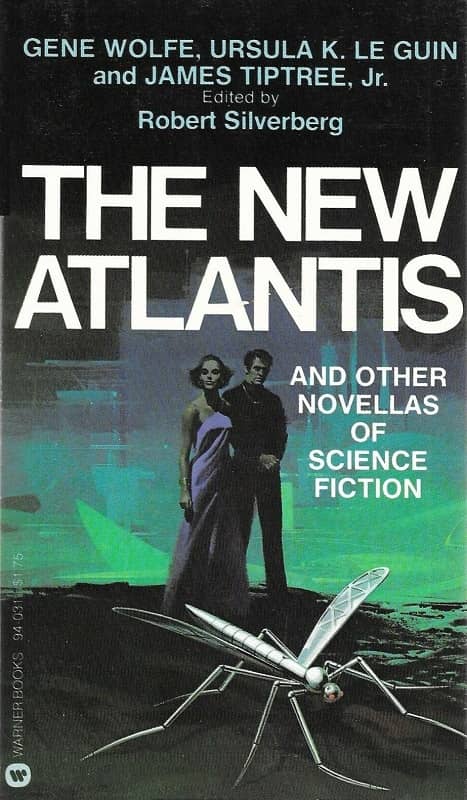 |
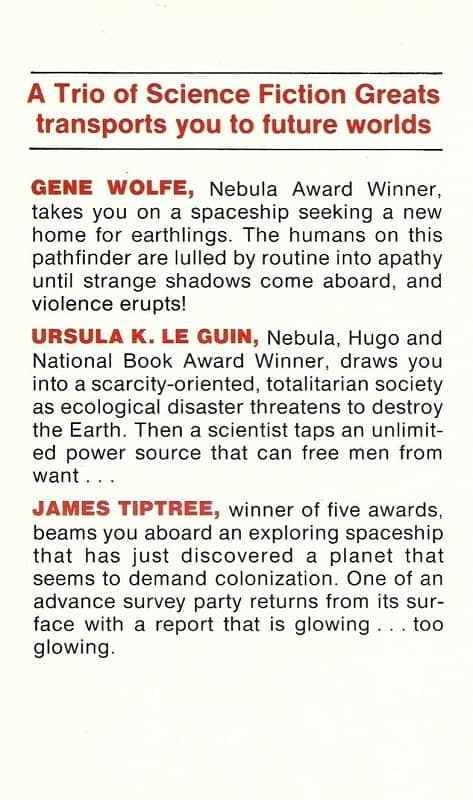 |
The New Atlantis (Warner Books paperback reprint, 1978). Cover by Lou Feck
My latest look at a book from the 1970s treats a major anthology from 1975. The New Atlantis and Other Novellas collects three long stories: “Silhouette,” by Gene Wolfe; “The New Atlantis,” by Ursula K. Le Guin, and “A Momentary Taste of Being,” by James Tiptree, Jr. The project received plenty of notice at awards time – the book as a whole was fifth in the Locus Poll for Best Anthology, “A Momentary Taste of Being” and “Silhouette” were 7th and 9th, respectively, in the Locus Poll for Best Novella, while “The New Atlantis” won the Locus Poll for Best Novelette, and received a Hugo nomination in that category, and both it and the Tiptree also got Nebula nominations.
Let’s look at the individual stories first.
“Silhouette” by Gene Wolfe
Gene Wolfe was a remarkable writer at all lengths — he produced brilliant short-shorts, short stories, novelettes, novellas, novels, series of novels, even a series of series of novels. “Silhouette,” at about 20,000 words, is one of his novellas — and it may be that the novella was his ideal length.
[Click the images for masterful versions.]
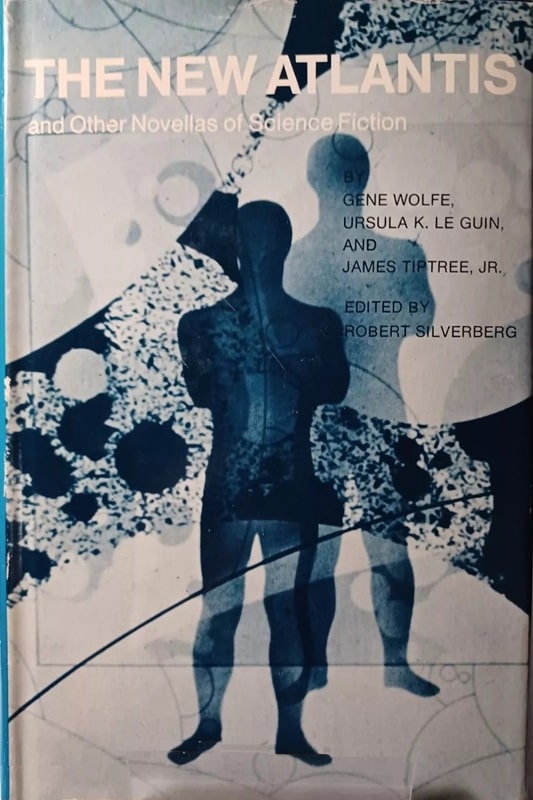
At any rate he wrote some 15 novellas, ranging from “The Fifth Head of Cerberus” in 1972, to “Memorare” in 2007; and of these at least “The Fifth Head of Cerberus,” “The Death of Dr. Island,” “Tracking Song,” “The Eyeflash Miracles,” “Seven American Nights,” and “The Ziggurat” rank among the great novellas in SF history. I don’t rank “Silhouette” quite with those stories, but it is a powerful and original piece.
A starship has reached a planet called Neuerrdraht, and the crew are considering whether it is suitable for human habitation. The viewpoint character is Johann, one of the officers, who is skeptical about the prospect of colonization. The ship is deteriorating, however, and the Captain is insistent. There are other factions, including a group that worships the ship’s computer… We get a flavor of life on the ship — a certain grunginess, oppressiveness, with features such as women (except for the Captain) being required to sleep with officers whenever available. Johann has dreams of walking on the surface of the planet, and he is visited by a — shadow? his shadow? something from the planet? A silhouette, at any rate!
The story continues in a disturbing fashion, as the atmosphere on the ship becomes darker. There’s a sense that the ship’s decay mirrors the decay on Earth, from which they had escaped. Johann finds himself confronting the computer-worshippers, and a group that seems intent on mutiny, and people ready to hurt him if he won’t cooperate. With the ambiguous help of the shadow being, he gets through all this, and then comes the actual mutiny, with chaotic and unexpected results.
This is a very good story, but as I said not quite Wolfe at his best. It lacks the truly mysterious aspect that I love most in Wolfe’s work. As I suggest above, I think the best way to read it is to see conditions on the ship as a sort of metaphor — a reflection, even a silhouette — of conditions on the Earth they left. The ship is full of class divisions, and sexual divisions: it’s a particularly oppressive place for women, it seems. And there is no reason to expect colonizing Neuerrdraht will solve anything.
“The New Atlantis” by Ursula K. Le Guin
This is the shortest of these stories, at perhaps 10,000 words. It is set in a ruined near future (to 1975) US, in which climate change has caused sea levels to rise and some parts of the coast are submerged. The country is ruled by a sort of corporatist tyranny, which to my eyes had both right-wing and left-wing elements. The narrator lives in Portland, and her husband has just returned from a prison camp — but they have to be careful, as in this future marriage is illegal. She is a musician, and her husband is a mathematician. And there are rumors of new continents emerging from the ocean.
The narrative alternates passages in the narrator’s POV, with passages from the POV of a mysterious underwater being. The narrator tells of ordinary life in this dismal future: practices her music in the bathroom to frustrate the bug they discovered there, and her husband has friends over, talking dangerously about politics and also about science — in particular, a discovery they have made of a very cheap and portable energy source. The corporatist rulers have a monopoly on energy, and there isn’t enough available to most people. Free energy will be wonderful but destabilizing to the government. . Meanwhile, the sea level keeps rising, and her husband’s risks are clearly threatening their life together. All along the underwater being is telling of what it witnesses, and it’s more or less clear that this is an entity on the rising continent.
The conclusion is mournful, ultimately. There is a sense — ambiguous perhaps — that humanity has irretrievably messed up the planet, and that the “New Atlantis,” which might have been a new sanctuary perhaps? 0r might represent a purified world? — will either be empty or available for humanity’s successors. (But really that’s my speculation purely.)
It’s obvious that aspects of this story seem prescient now, though the story certainly isn’t (and wasn’t trying to be) an accurate prediction of our times. It’s more of an impressionistic, and somewhat despairing, depiction of a decay Le Guin foresaw. And it’s beautifully written.
“A Momentary Taste of Being” by James Tiptree, Jr.
This story is by far the longest story here, at some 37,000 words, occupying well over half the book. The setup is curiously similar to that of Wolfe’s “Silhouette”: a starship, the Centaur, has come from a ravaged Earth hoping to find a suitable planet to colonize. As the ship’s name suggests, the solar system being investigated is Alpha Centauri, and as the action opens, Dr. Lory Kaye is in quarantine, having just returned from an expedition to a promising planet. She returned alone, leaving the fellow members of the expedition on the planet, which seems to be a wonderful place, in her telling. She has also brought back a sample of alien life, a large plant-like being. Her ship, and she herself, are quarantined. The story is told from the POV of her brother, Dr. Aaron Kaye, the chief medical officer.
Lory’s tale is received suspiciously by some of the officers. There is minimal actual data retrieved from the planet. There are some hints of what seems to have been violence, or at least disagreements between the various planetary explorers. And there seem to be strange effects on everyone who gets anywhere near the alien plant. But everyone is exhausted by their long mission (10 years) and there is a sense that this is the last chance for the people of Earth. Aaron himself is one of the more skeptical about the planet’s prospects, as is their alcoholic captain. But others desperately want to immediately colonize the planet and send a signal to Earth for others to follow. One man tells Aaron of his plans to set himself up as a sort of petty ruler, complete with an harem (that would include Aaron’s lover Solange.) Aaron, too, is torn by his loyalty to his sister, with whom he had an extended incestuous relationship through their teens.
The story is a rather a slow burn — with a very extended telling of the final day or so of Lory’s quarantine, and of the plans to study the alien plant she brought back; as well as some flashback to Aaron and Lory’s past, and depictions of Aaron’s interactions with other crew members, including a horribly injured man named Tighe, as well as Captain Yellaston, whose alcohol is supplied by Aaron; and the various other officers with their motivations, and descriptions of the somewhat unstable mental state of just about everyone.
But it all culminates in a really powerful final scene, as the nature of the alien plant creature is revealed, and Tiptree’s metaphor for what is really going on becomes clear. It’s a very Tiptree-like ending, and, like so many of her stories, it’s fundamentally about sex and death. Part of me wishes it was somewhat shorter, but perhaps the drawn out beginning is necessary to set up the conclusion. It’s not Tiptree’s greatest story, but it’s one of her most characteristic, I think, and it’s really despairingly effective. Tiptree’s vision, it seems to me, never exactly sunny, became darker and darker throughout the ’70s, culminating in 1980 with “Slow Music,” often called her last great story.
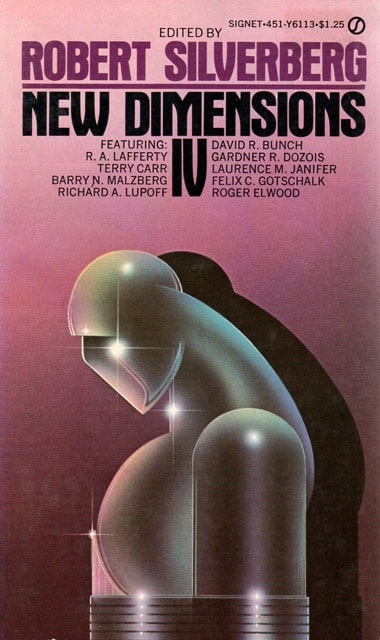 |
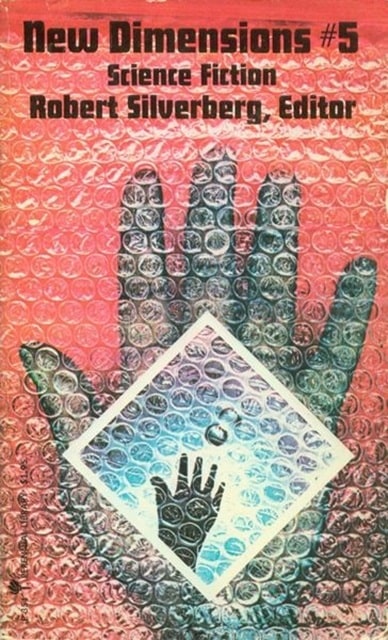 |
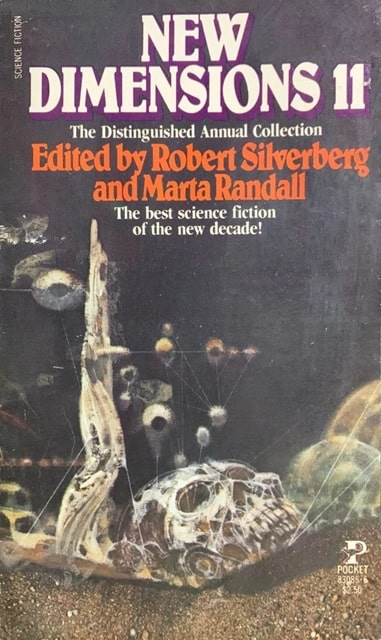 |
Three volumes of Robert Silverberg’s New Dimensions: IV (Signet, October 1974),
5 (Perennial Library, September 1976), and 11 (edited with Marta Randall,
Pocket Books, July 1980). Cover art: unknown, Joe Harris, Richard Powers
Summary
This anthology highlights an aspect of Silverberg’s career for which he perhaps hasn’t gotten the credit he deserves: his influence on SF as an editor and anthologist. And it is possible that the single best original anthology Robert Silverberg produced was this one — The New Atlantis. The three stories are by three of the greatest SF writers of all time, each at the absolute height of their powers. (And, as Silverberg notes in his introduction, all three of these writers came to SF fairly late.)
Silverberg’s editorial contributions go well beyond this book. His original anthology series New Dimensions is remarkable as well, featuring a great many of the best stories of its time. The massive original anthology Epoch (co-edited by Roger Elwood) was far better than its Elwood-stained reputation suggests. He produced many more original anthologies (see sidebar below).
He was also a prolific anthologist of older stories, most notably The Science Fiction Hall of Fame, Volume I, and a wonderful set of 7 books called Alpha. He published quite a few more short anthologies of older SF, and some later doorstops, both original (as with the Legends books, and Far Horizons, plus three books following on the late Terry Carr’s Universe series that he co-edited with his wife Karen Haber), and also reprint books, particularly two Arbor House collections of Great Short Stories and Great Short Novels.
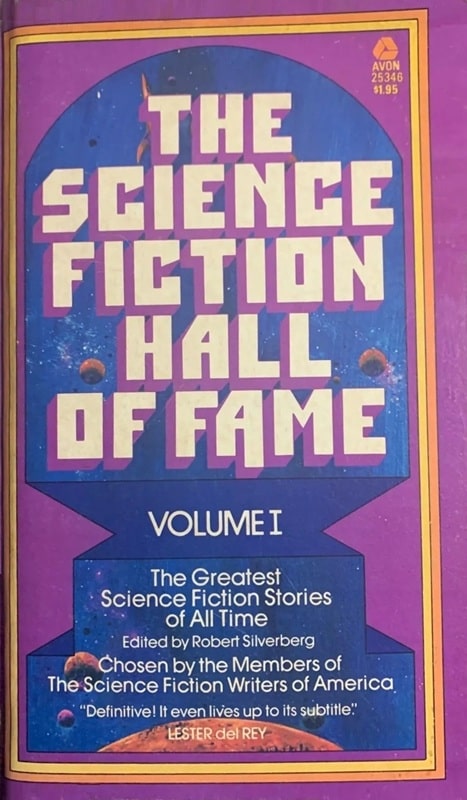 |
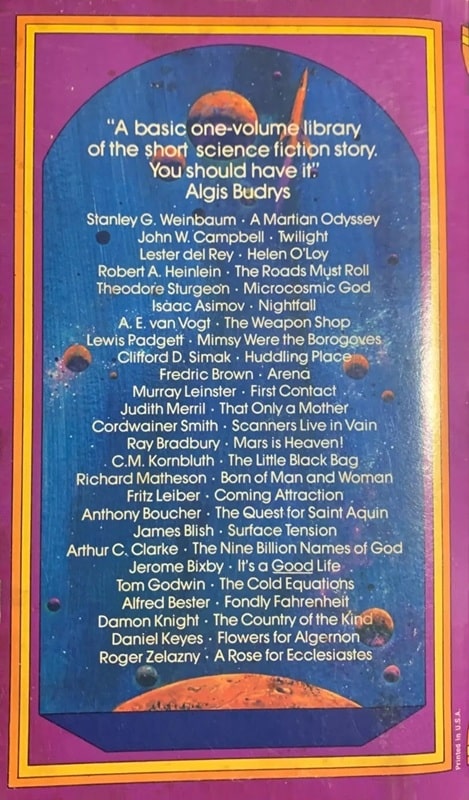 |
The Science Fiction Hall of Fame, Volume I, edited by Robert Silverberg (Avon, July 1971).
Sidebar: Robert Silverberg’s Novella Anthologies
In the decade from 1969 to 1979, Robert Silverberg edited 11 anthologies of original novellas. (One book had four stories.) At the same time Silverberg was producing his original anthology series New Dimensions, and his reprint series Alpha. And that’s not to mention his own fiction — despite a retirement during this period he published some 15 novels and dozens of short stories.
Relatively few examples in the three novella format come from other editors. Silverberg’s primary rival (as I perceive it), Terry Carr, did just one “three novella” book, though a very good one, An Exaltation of Stars. The super prolific Roger Elwood published three, Futurelove, A World Named Cleopatra (with Poul Anderson), and In the Wake of Man. That last book, which had stories by R. A. Lafferty, and Walter F. Moudy, is one of Elwood’s very best, particularly as it features one of Gene Wolfe’s greatest novellas, “Tracking Song.”
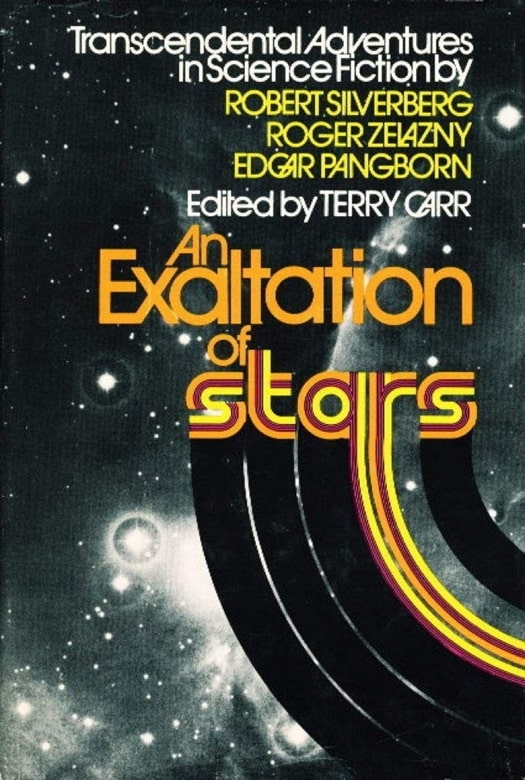 |
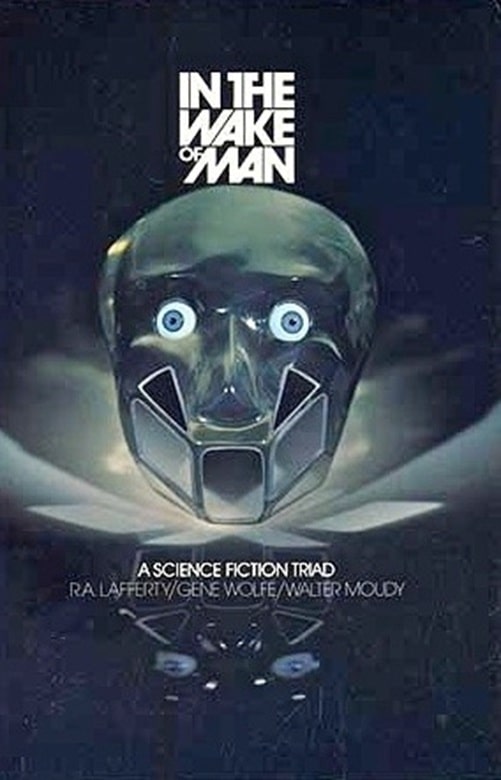 |
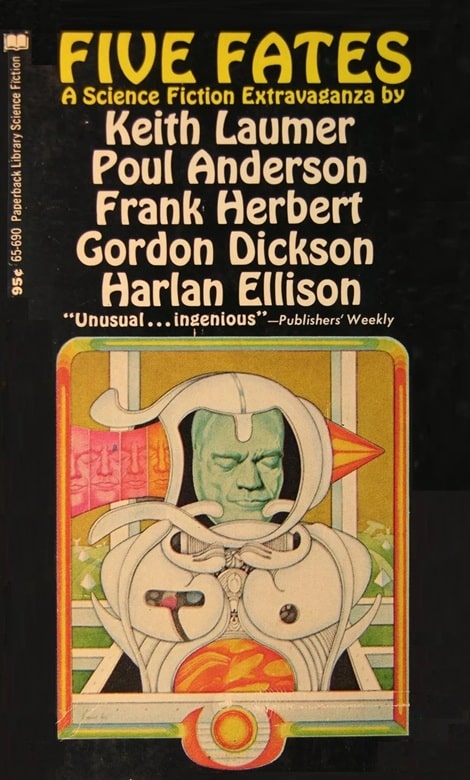 |
Other anthologies in a novella format: An Exaltation of Stars, edited by Terry Carr (Simon &
Schuster, June 1973), In the Wake of Man, edited by Roger Elwood (Bobbs-Merrill Company,
August 1975), and Five Fates, edited by Keith Laumer (Paperback Library, September 1971).
Cover art by Adelson & Eichinger, Nick Aristovulos, Lorraine Fox
The Anderson collaboration has four stories, all set on the title world, a creation of Anderson’s. (In this sense it mildly resembles the Twayne Triplets of the 1950s, which collected three novellas on the same subject, based on an introductory essay. Several of those books were planned, but in the end only two appeared, Witches Three and The Petrified Planet.) One other anthology of interest is a 1970 book put together by Keith Laumer, Five Fates, in which five writers continued a brief introduction by Laumer, in which a man goes to a Euthanasia center and begins to die — each writer then extrapolates what may happen to this man after (?) death.
Here are the eleven “novella” books Silverberg did.
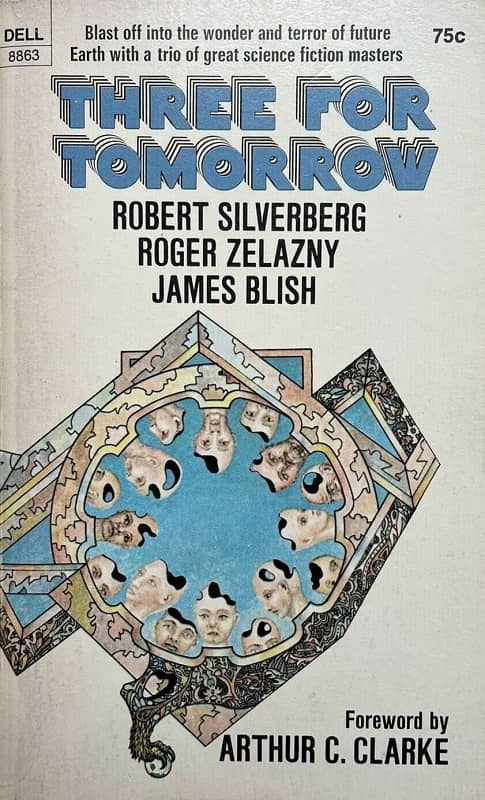 |
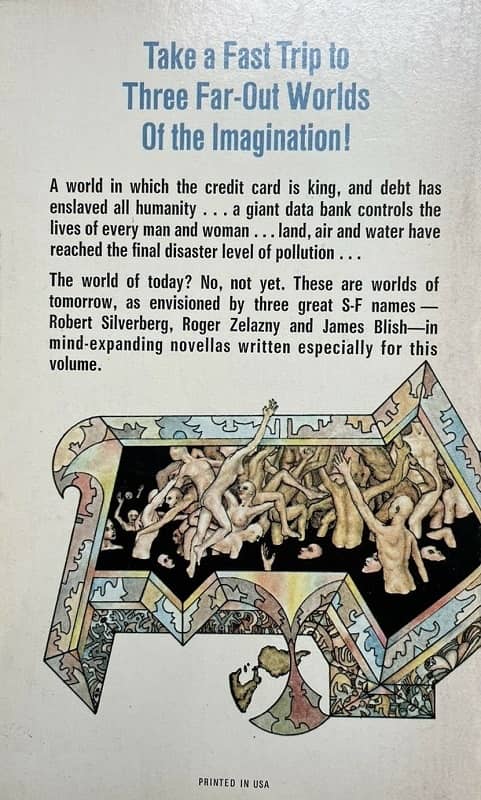 |
Three for Tomorrow (Dell, 1970). Cover uncredited
Three for Tomorrow (1969)
How It Was When the Past Went Away • novella by Robert Silverberg
The Eve of RUMOKO • novella by Roger Zelazny
We All Die Naked • novelette by James Blish
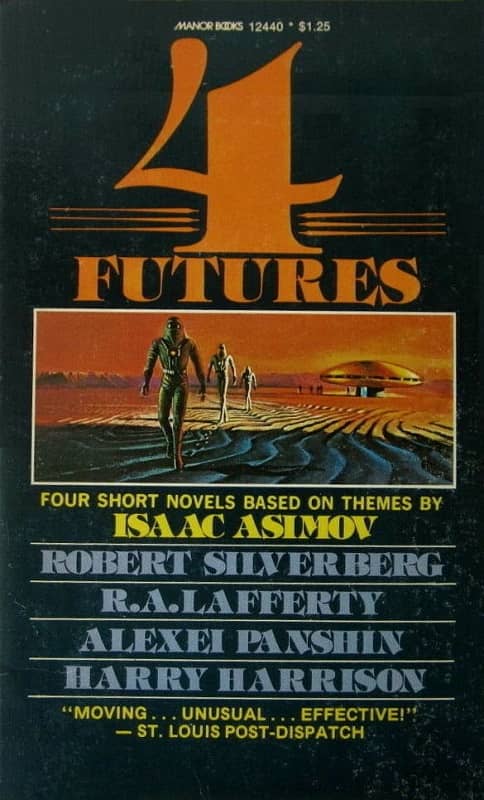 |
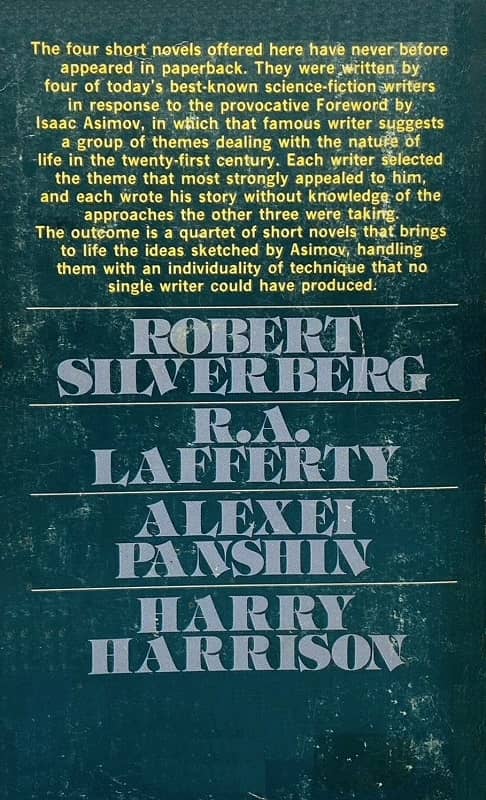 |
4 Futures (Manor Books, 1976 ). Cover by Bruce Pennington
Four Futures (1971)
Ishmael Into the Barrens • novelette by R. A. Lafferty
Brave Newer World • novelette by Harry Harrison
How Can We Sink When We Can Fly? • novelette by Alexei Panshin
Going • novella by Robert Silverberg
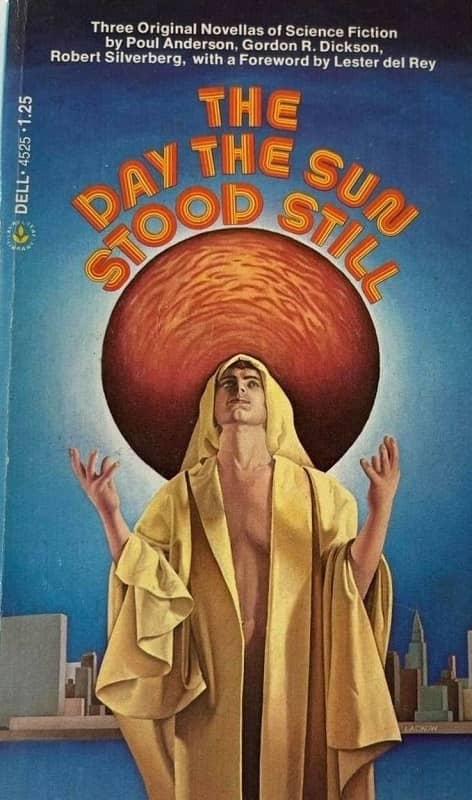 |
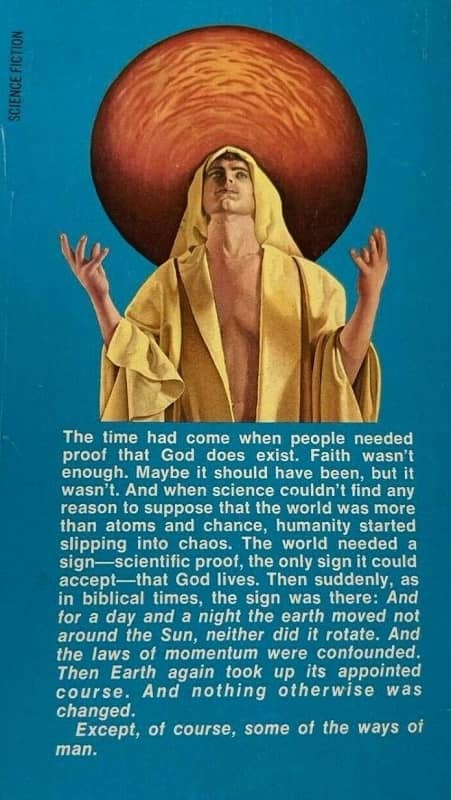 |
The Day the Sun Stood Still (Dell, 1975). Cover by Andy Lackow
The Day the Sun Stood Still (1972)
Thomas the Proclaimer • novella by Robert Silverberg
A Chapter of Revelation • novella by Poul Anderson
Things Which Are Caesar’s • novella by Gordon R. Dickson
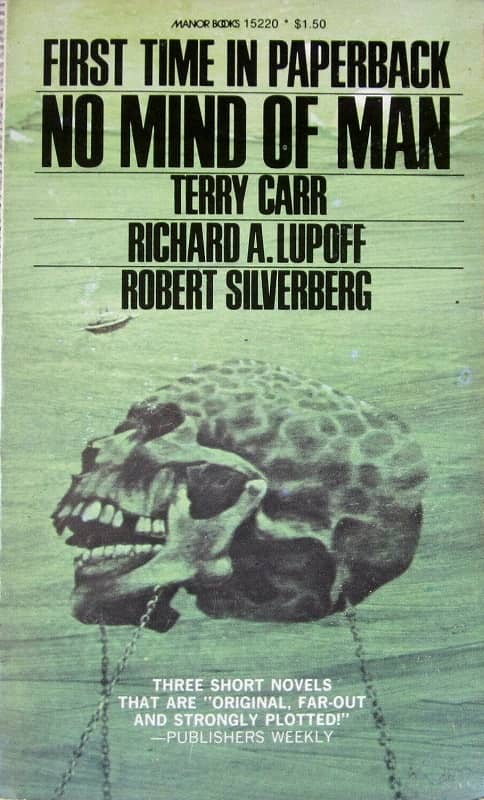 |
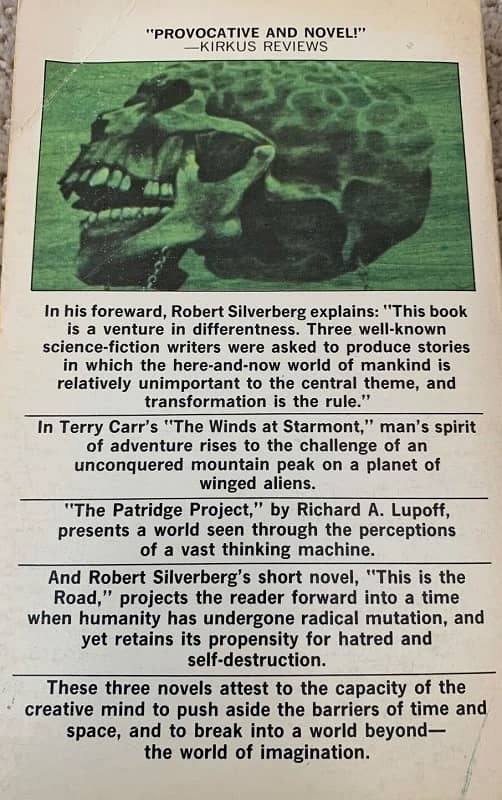 |
No Mind of Man (Manor Books, 1973). Cover uncredited
No Mind of Man (1973)
The Winds at Starmont • novella by Terry Carr
The Partridge Project • novella by Richard A. Lupoff
This Is the Road • novella by Robert Silverberg
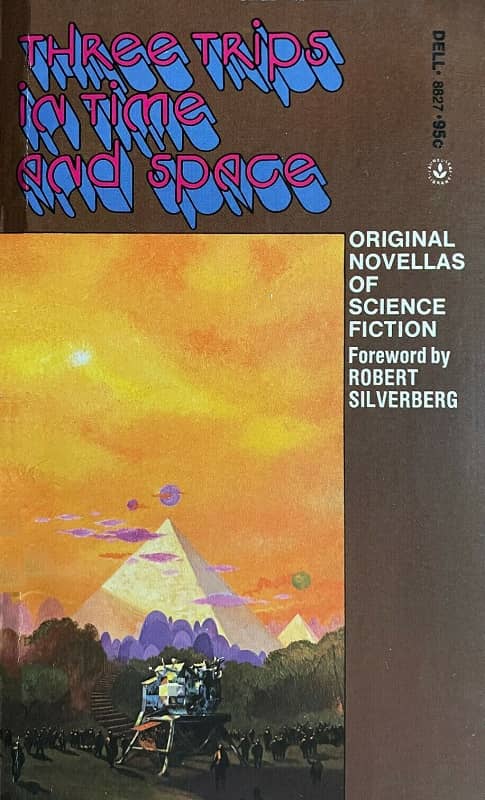 |
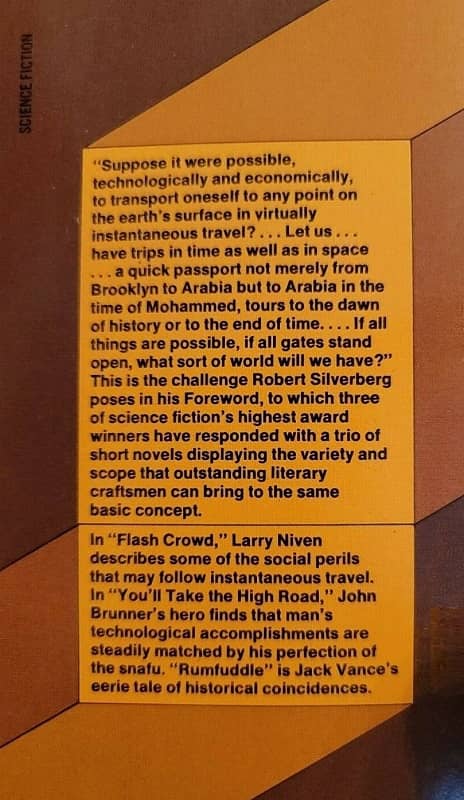 |
Three Trips in Time and Space (Dell, 1974). Cover by Paul Lehr
Three Trips in Time and Space (1973)
Flash Crowd • novella by Larry Niven
You’ll Take the High Road • novella by John Brunner
Rumfuddle • novella by Jack Vance
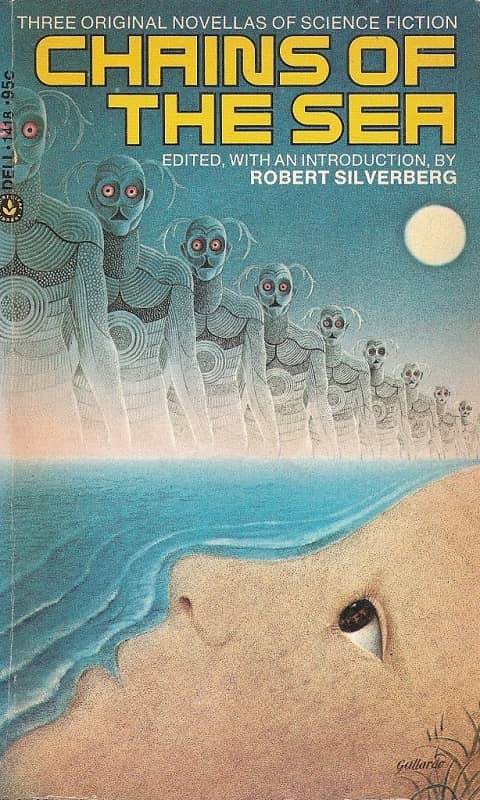 |
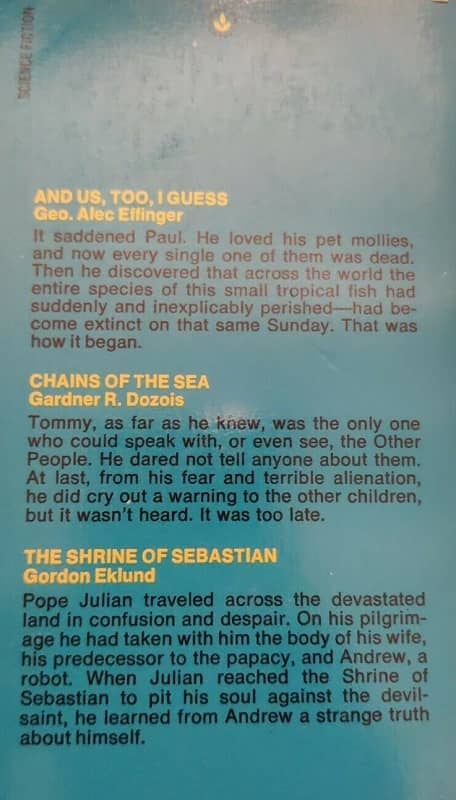 |
Chains of the Sea (Dell, 1974). Cover by Gervasio Gallardo
Chains of the Sea (1973)
And Us, Too, I Guess • novella by George Alec Effinger
Chains of the Sea • novella by Gardner Dozois
The Shrine of Sebastian • novella by Gordon Eklund
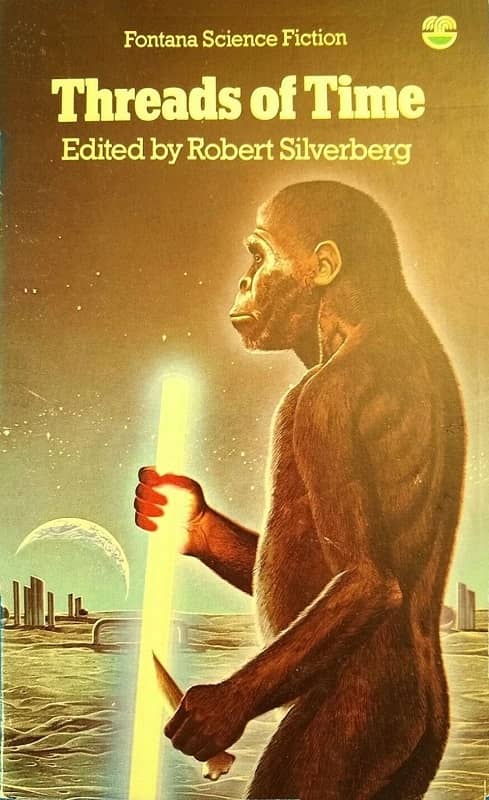 |
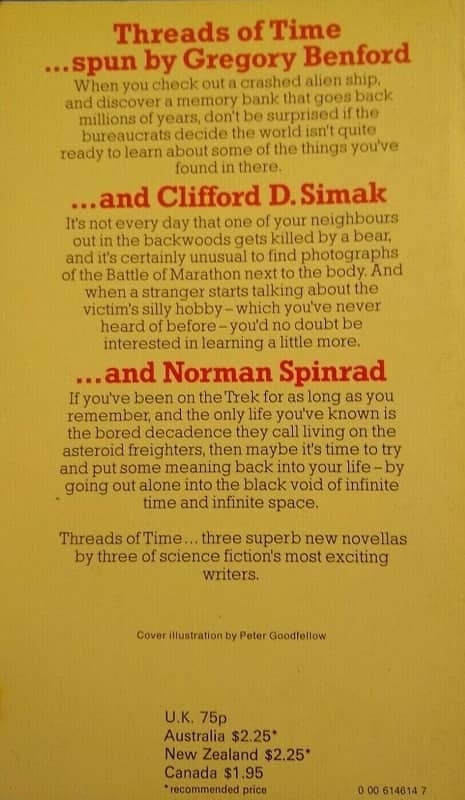 |
Threads of Time (Fontana, 1977). Cover by Peter Goodfellow
Threads of Time (1974)
Threads of Time • novella by Gregory Benford
The Marathon Photograph • novella by Clifford D. Simak
Riding the Torch • novella by Norman Spinrad
 |
 |
The New Atlantis (Warner Books, 1978). Cover by Lou Feck
The New Atlantis (1975)
Silhouette • novella by Gene Wolfe
The New Atlantis • novelette by Ursula K. Le Guin
A Momentary Taste of Being • novella by James Tiptree, Jr.
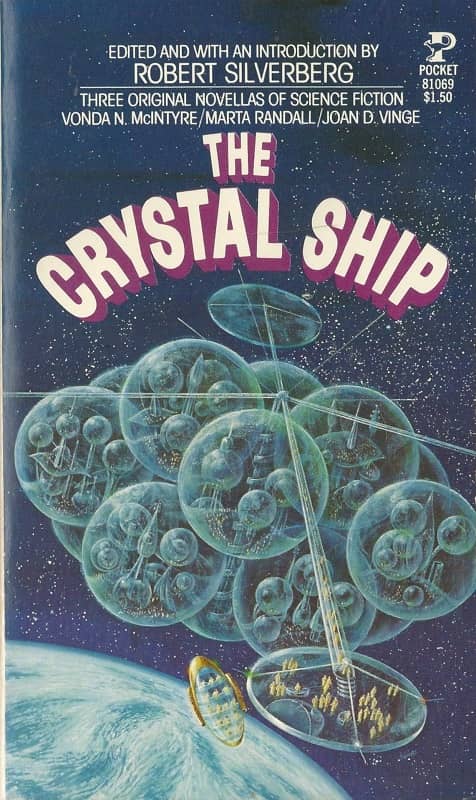 |
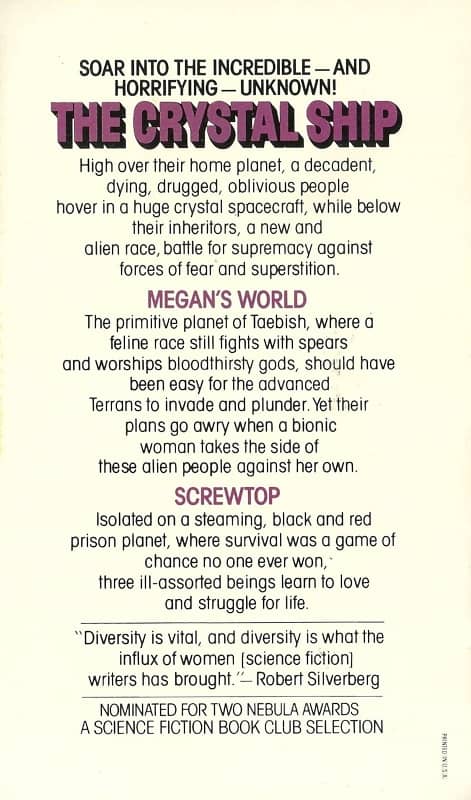 |
The Crystal Ship (Pocket Books, 1977). Cover byNorman Adams
The Crystal Ship (1976)
The Crystal Ship • novella by Joan D. Vinge
Megan’s World • novella by Marta Randall
Screwtop • novella by Vonda N. McIntyre
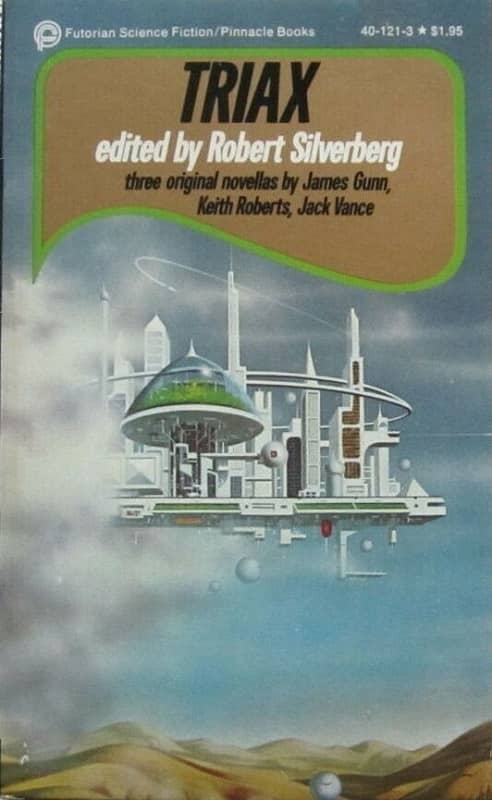 |
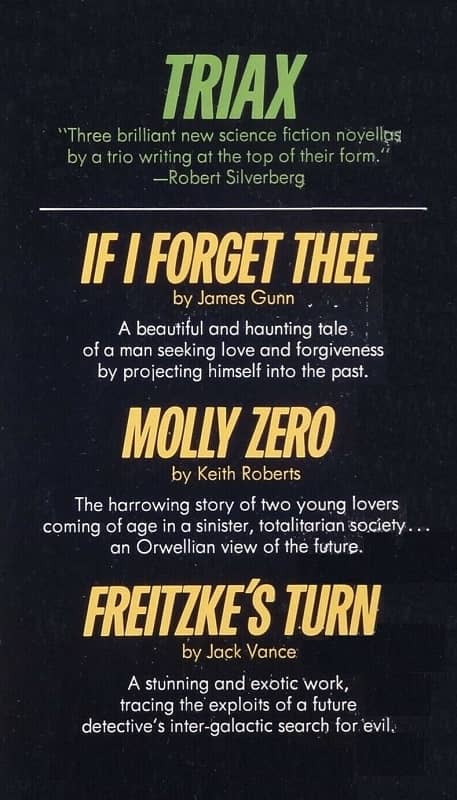 |
Triax (Pinnacle, 1977). Covers by Randy Weidner
Triax (1977)
Molly Zero • novella by Keith Roberts
If I Forget Thee • novella by James E. Gunn
Freitzke’s Turn • novella by Jack Vance
The Edge of Space hardcover edition (Elsevier/Nelson Books, 1979). Wraparound cover by Freff
The Edge of Space (1979)
The King’s Dogs • novella by Phyllis Gotlieb
In the Blood • novella by Glenn Chang
Acts of Love • novella by Mark J. McGarry
Rich Horton’s last article for us was an obituary for Barry N. Malzberg. His website is Strange at Ecbatan. Rich has written over 200 articles for Black Gate, see them all here.

I think A Momentary Taste of Being is an absolutely devastating story, and I actually think it might have been even more effective at a longer length rather than a shorter one; I’ve always wondered why Sheldon/Tiptree didn’t make it a full-fledged novel. All it would have taken was an opening section set on earth before the launching of the Centaur, showing just how bad (how overheated and tumescent, if you will, given the meaning of the story) things had become. Either way, not the feel-good story of the year, but she wasn’t in that business.
The ending it so good, really, and Tiptree makes a concept really powerful, one that in other hands (I’m looking at you, Kurt Vonnegut!) is just silly.
The difficulty with the three-novella format is that if just one is bad, or even mediocre, it tends to drag the book down with it. So I’m not surprised it didn’t catch on. OTOH when all three are outstanding and hang together as a group, as in this case, it’s a thing of beauty.
Several of these sound very interesting. I may have to find the one with the James Gunn story–one I haven’t heard of.
There are of course three doorstops from the early 1980s, not two: The Arbor House Treasury of (1) Modern Science Fiction, (2) Great Science Fiction Short Novels, and (3) Science Fiction Masterpieces. It was Silverbob’s plan to have all three reprinted by Wildside Press, but there seems to have been some sort of mixup, since only the second and third books appeared, while the first one seems (to me) be the most important one to get. The first book, “Modern”, has no overlap with The Science Fiction Hall of Fame, Volume One (perhaps by design?), so those two books make a great crash course in short SF up to 1980.
It’s a great sadness to me that books like this are hardly ever published any more.